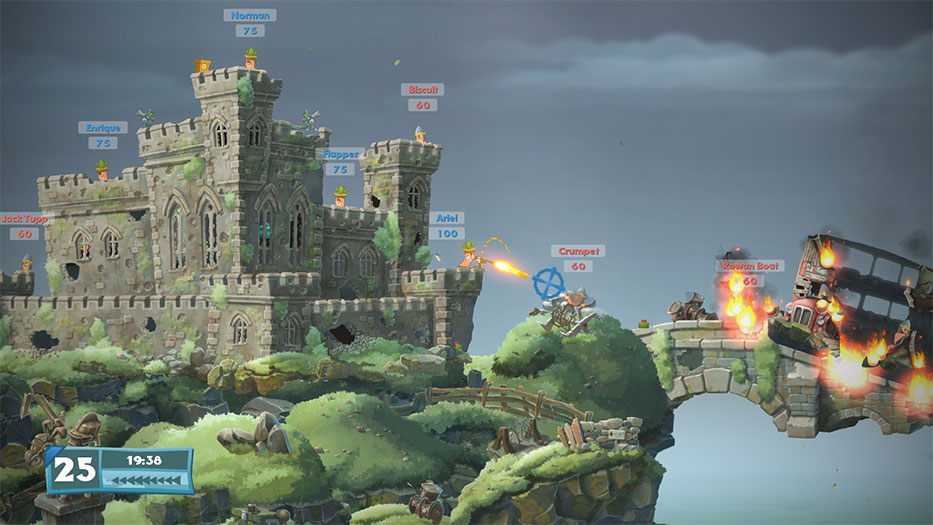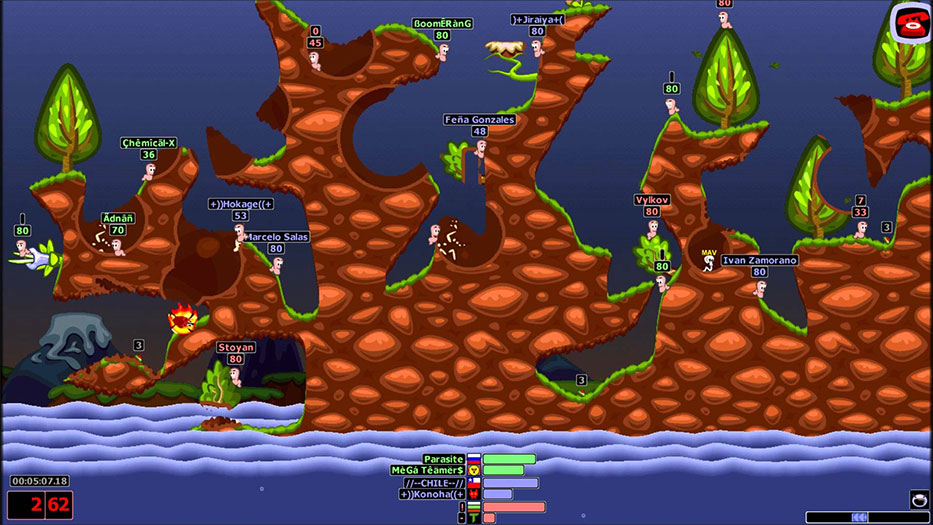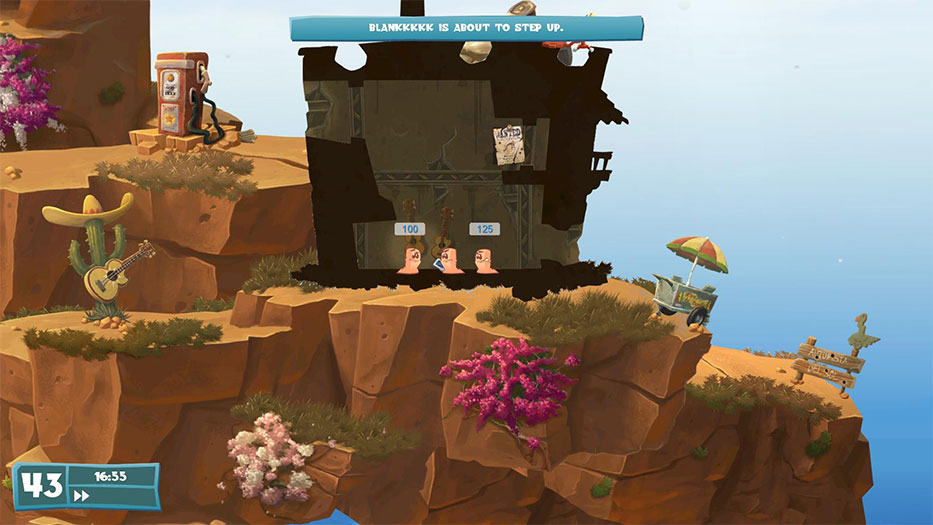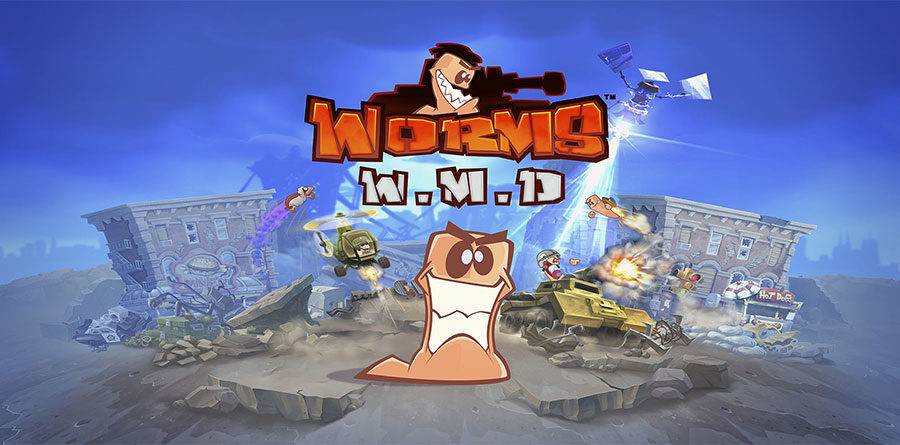With the release of Worms: WMD, I’ve decided to take a moment and muse on my personal loyalty to the franchise. I’ve played every Worms game since Armageddon in 1999 (the first was released in ’95 but, since I spent much of that year as a foetus, I feel I can be excused- the womb is no place for a PlayStation). Thing is, twenty one years later, the amount of actual changes to the gameplay mechanics can be counted on the fingers of a blind butcher. Why, then, do I keep coming back?

Slightly redesigned, but no less appealing
New Features
The core gameplay in this latest addition plays much as it ever did; the iconic Bazooka is joined by an arsenal of familiar faces and a few new ones to bolster the ranks. A personal favourite of the new additions is the Carpet Bomb, which involves a series of exploding carpets. All the same, even these new weapons aren’t sufficient to warrant a whole new game based around them; there must be something else!
It’s true that a couple more mechanics were added to the game; additional layers of strategy may be found in the inclusion of vehicular combat and the ability to craft new weapons on the fly. Both demand a fresh perspective and a degree of skill and time management, as you desperately juggle the creation of a fresh Banana Bomb and the ultimate goal of lobbing a Sheep at a woolly-hat wearing Worm as a form of ironic retribution.
On the other hand, though, it seems the Class system of the last couple of games, in which Worms were assigned the roles of Soldier, Scientist, Scout or Heavy, has now been abandoned, as has the much-prized “dynamic water”, that well-known facilitator for a watery grave. Team17 giveth, Team17 taketh away.
This trade-off of two new mechanics for another two only serves to reinforce the notion that, ultimately, these games remain the same, regardless of what shiny new features may have been temporarily affixed to them. Why, then, do I keep coming back?

The series hasn’t changed much since 1999
The Draw of the Worms Franchise
I believe there are elements of gaming that are more transcendent, more difficult to pin down, than- well- gameplay. The Worms franchise exemplifies a number of these factors that, though they may not be obvious, cause a game to worm its way into our hearts.
Firstly, there is a huge amount of humour embedded in the series. Ordinarily, such a well-known series will spurn funnier moments in favour of an extra bucket or two of grit and darkness. I don’t recall Batman cracking many jokes while trapped in Arkham, and nor does the Master Chief tend to have time to squeeze in a gag in any of his customary three lines per game. While there’s much fun to be had with smaller, indie titles (I am Bread springs to mind, given that the entire concept is, fundamentally, funny) the gaming elite often eschews such things. It’s no wonder, then, that I’ll greedily grab anything that’ll make me laugh, so starved I am of any chuckles as I wearily blow up another one of Marcus Phoenix’s underground gribblies.

The second pull factor is, admittedly, a little more niche, but nonetheless: I am British, and it does feel good to play a game created by a British company, and all the references that entails. In games past, this has involved the voice talents of such esteemed British actors as Matt Berry and Katherine Parkinson. In the latest game specifically, meanwhile, we have a whole voice bank based upon the protagonist of classic sitcom Keeping Up Appearances. It’s niche, it’s not a major selling point, but I love it. A company prepared to put in this level of detail and love is always one I’m prepared to support.
Beyond the tone, the laughter and the Britishness, there’s another feature: the aesthetic. The Worms have had a bit of a redesign this time around but, as ever, they remain fundamentally cute (always a nice feature in a creature I’m trying to destroy with a well-placed Old Woman). Between the adorable Worms and the environments which have only grown in detail and splendour over the years, there’s a great deal of appeal in the level of sheer eye candy with which we’re presented. Yes, other games are also well-presented, but there’s a crucial difference between the Worms and the rest, and one that forms the basis of my final point: the money.
There are, after all, other franchises that, many critics argue, give us much the same content year after year. Call of Duty, Assassin’s Creed and Fifa (to name but a few) are similarly repetitive in terms of mechanics and frequent in terms of production, but the fact of the matter is that these games benefit from showers of cold, hard cash. They’re up to their knees in the stuff; the Ubisoft people aren’t exactly going hungry at the moment!
In fact, I Googled the revenues of Ubisoft and Team17. It is vulgar to mention specifics, but the results did make me feel a little lightheaded.
So, there you have it. Team17 have achieved the kind of intoxicating effect in their games that other, bigger studios do at a fraction of the cost, and their cosy, small-time British tone increases this appeal in a way that bigger developers can only dream of. After twenty one years, it seems the Worms’ greatest weapon is a full payload of whimsical adventure.









